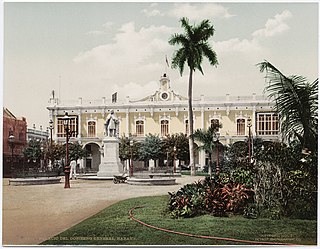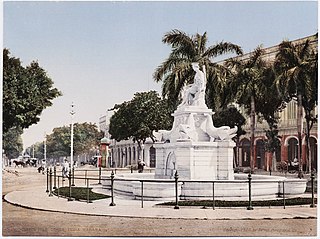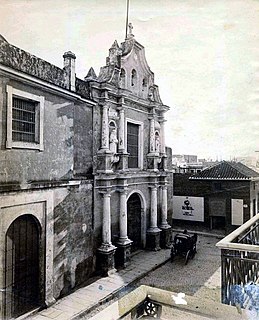
Havana is the capital and largest city of Cuba. The heart of the La Habana province, Havana is the country's main port and leading commercial center. The city has a population of 2.1 million inhabitants, and it spans a total of 781.58 km2 (301.77 sq mi) – making it the largest city by area, the most populous city, and the fourth largest metropolitan area in the Caribbean region.

Havana Cathedral is one of eleven Catholic cathedrals on the island. It is located in the Plaza de la Catedral on Calle Empedrado, between San Ignacio y Mercaderes, Old Havana. The thirty by forty-nine meters rectangular church serves as the seat of the Roman Catholic Archdiocese of San Cristobal de la Habana. Christopher Columbus’ remains were kept in the cathedral between 1796 and 1898 before they were taken to Seville Cathedral.

El Capitolio, or the National Capitol Building, is a public edifice in Havana, the capital of Cuba. The building was commissioned by Cuban president Gerardo Machado and built from 1926 to 1929 under the direction of Eugenio Rayneri Piedra. It is located on the Paseo del Prado, Dragones, Industria, and San José streets in the exact center of Havana.

The Roman Catholic Metropolitan Archdiocese of San Cristobal de la Habana is one of three Catholic archdioceses in Cuba.

La Mansión de Mark Pollack, is a neo-classical, Florentine mansion in the Cubanacan Section of Havana, Cuba built in 1930 by the Cuban architect, Leonardo Morales y Pedroso (1887–1965). It is located at 21st street #15001, Cubanacan, Havana, Cuba. It was built for Mark Alexander Pollack (1874–1946),the son of Alexander Pollack and Belle A. Rothschild (1848-1936), the American-born patriarch of a wealthy Cuban tobacco exporter. The house covers an area of 13,000 square meters.

Jean-Claude Nicolas Forestier was a French landscape architect who trained with Adolphe Alphand and became conservator of the promenades of Paris.

The Palacio de los Capitanes Generales is the former official residence of the governors of Havana, Cuba. Located on the eastern side of the Plaza de Armas in Old Havana it is home to the Museum of the City of Havana. It houses exhibitions of art and historical artefacts and many of the rooms are preserved with their original Colonial decoration.

Paseo del Prado, is a promenade in Havana, Cuba near the old city wall, and the division between Centro Habana and Old Havana. Technically, the Paseo del Prado includes the entire length of Paseo Martí approximately from the Malecon to Calle Máximo Gómez, the Fuente de la India fountain. The promenade has had several names, it was renamed Paseo de Martí in 1898 with the island's independence from Spain. Despite the historic references, the people of Havana simply call it "El Prado."

Fuente de la India is a fountain by Giuseppe Gaggini in Havana, Cuba, at the south extreme of Paseo del Prado, about 100 m south of El Capitolio, between Monte and Dragones Streets. The figure represents the Indian woman "Habana" in whose honor Havana was named.
The following is a timeline of the history of Havana, Cuba.

The Parque Central, Havana is one of the best known and central sites of the city of Havana, Cuba. It is located between Prado, Neptuno, Zulueta and San José streets, and San Rafael Boulevard. Among the buildings surrounding the park are Gran Teatro de La Habana, the Hotel Inglaterra, the Hotel Telégrafo, el Hotel Parque Central, la Manzana de Gómez, the Hotel Plaza and Museo Nacional de Bellas Artes.

The Iglesia del Espíritu Santo at #161 Calle Acosta was built in 1635 on the corner of the corner of Calles Cuba and Acosta by a fraternity of Afro-Cuban ex slaves. The Espíritu Santo contains some notable paintings including a seated, post-crucifixion Christ on the right wall, and catacombs. It is considered one of the oldest temples in Havana and it is said that its main interest lies essentially in the simplicity or simplicity of the beautiful stone construction.

The Iglesia de San Francisco de Paula, Havana is part of the ecclesiastical heritage of Havana. It is located at 110 Calle Leonor Pérez on the corner of Calle San Ignacio. It is near the bay on the south side of Havana Vieja."

The Paseo de Tacón, or Paseo Militar, was created by the Captain General Miguel Tacón y Rosique (1834–1838) who promoted the reform of the “road” that, starting from the calles of San Luis de Gonzaga (Reina) and Belascoáin, connected to the Castillo del Príncipe. Calle Belascoáin was the edge between the city and the countryside.

The paseo marítimo of Pontevedra is a pedestrian way along the seafront facing the ria of Pontevedra, in Pontevedra, Spain. This coastal public space is built in the urban and semi-urban area of the city and defines its encounter with the sea and the Lérez river.

The Hotel Pasaje was located on Paseo del Prado between San José and Dragones, facing the National Capitol.

The Cuartel de Milicias was the largest barracks in the city of Havana in the 18th century. Conceived as the headquarters of the militia battalions that at that time were classified according to their member's skin color, white, or brown.
Antonio Fernandez de Trebejos and Zaldivar was an 18th-century architect, colonel of engineers in the Spanish army, author of some of the most notable Havana buildings of the colonial era.

The Coliseum was the first building erected in Havana to provide theatrical performances, it opened its doors on January 20, 1775. It was located in front of the Alameda de Paula between Calles Acosta, Oficios, and Luz, in Old Havana.

During the intervention of the United States government in Cuba (1898-1902), in order to beautify the new coastline of the Malecón, honor the medical students, widen the Paseo del Prado, and serve as a roundabout for the Malecón a kind of pavilion was built to house the evening concerts of the Municipal Band.


![Frederic Mialhe_Album pintoresco de la Isla de Cuba. Showing Alameda de Paula [1] with the Hospital and Iglesia de San Francisco de Paula. 1840. It was given the name Alameda de Paula because of its proximity to the old Hospital and Iglesia of San Francisco de Paula. Frederic Mialhe Album pintoresco de la Isla de Cuba.jpg](http://upload.wikimedia.org/wikipedia/commons/thumb/d/d6/Fr%C3%A9d%C3%A9ric_Mialhe_%C3%81lbum_pintoresco_de_la_Isla_de_Cuba.jpg/330px-Fr%C3%A9d%C3%A9ric_Mialhe_%C3%81lbum_pintoresco_de_la_Isla_de_Cuba.jpg)























